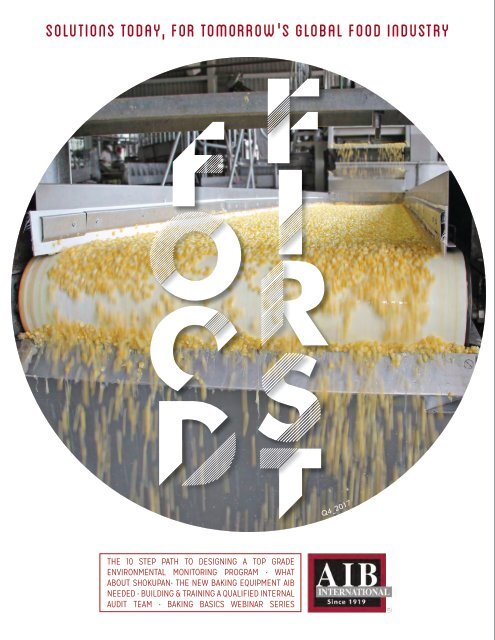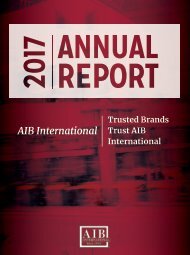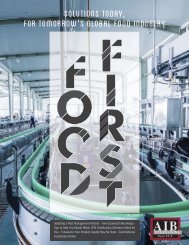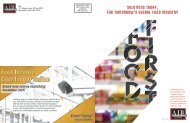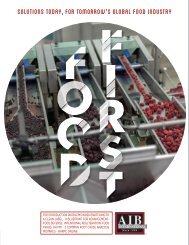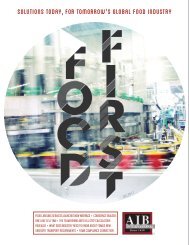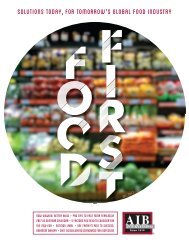AIB Q4 2017 Magalog
Create successful ePaper yourself
Turn your PDF publications into a flip-book with our unique Google optimized e-Paper software.
SOLUTIONS TODAY, FOR TOMORROW’'S GLOBAL FOOD INDUSTRY<br />
<strong>Q4</strong>_<strong>2017</strong><br />
THE 10 STEP PATH TO DESIGNING A TOP GRADE<br />
ENVIRONMENTAL MONITORING PROGRAM • WHAT<br />
ABOUT SHOKUPAN• THE NEW BAKING EQUIPMENT <strong>AIB</strong><br />
NEEDED • BUILDING & TRAINING A QUALIFIED INTERNAL<br />
AUDIT TEAM • BAKING BASICS WEBINAR SERIES
Foodborne illness outbreaks are in<br />
the news more and more – often from<br />
the result of poor hygiene practices.<br />
Post-lethality recontamination remains<br />
a serious concern. It’s critical to<br />
monitor the hygienic environment<br />
with an Environmental Monitoring<br />
Program (EMP) used to measure the<br />
overall effectiveness of your sanitary<br />
design, personnel practices, and<br />
operational methods. EMPs verify that<br />
cleaning and sanitizing procedures<br />
are adequate and act as an early<br />
warning tool to assess the risks posed<br />
by pathogens of concern. Use our 10<br />
step path to designing an EMP that<br />
excels.<br />
The 10 Step Path to Designing a Top<br />
Grade Environmental Monitoring Program<br />
Step 1: Create an EMP Team<br />
Bring together employees from<br />
various areas to form your team. The<br />
quality manager, plant microbiologist,<br />
line supervisors, plant engineer,<br />
and sanitation supervisors are all<br />
great candidates. This team will be<br />
responsible for identifying areas<br />
where the product may be at risk of<br />
contamination, marking the hygienic<br />
zones, and identifying sampling sites.<br />
Step 2: Apply the Zoning<br />
Concept<br />
The best way to identify sampling<br />
points is to use the zoning<br />
concept. Based on the sanitary<br />
zoning concept, the operation is<br />
divided into four zones that cover<br />
every area from direct foodcontact<br />
surfaces to areas remote<br />
from product processing areas.<br />
Step 3: Use<br />
Indicator Bacteria/<br />
Microorganisms<br />
Indicator microorganisms are<br />
optimal for the EMP because<br />
they are high in number and<br />
easy to enumerate. A positive<br />
indicator means possible<br />
contamination and a risk of<br />
foodborne disease.<br />
Step 4: Set Sampling<br />
Frequencies<br />
Swab all potential sites<br />
within a defined period<br />
of time (e.g., one month)<br />
so that both food-contact<br />
surfaces and non-food<br />
contact surfaces are<br />
tested at each sampling<br />
time.<br />
Step 5: Perfect Labeling and<br />
Shipping Procedures<br />
Some facilities test their swab<br />
samples in house and others use<br />
outside labs. To ensure accurate tests<br />
make sure key information, such as<br />
date, location, product size, and<br />
date submitted to lab, is included<br />
in your swab labeling and shipping<br />
procedures.<br />
Step 6: Establish a<br />
Baseline/Target<br />
Use historical results (e.g.,<br />
previous year data) and<br />
regulatory guidelines to establish<br />
a baseline. For example, if a<br />
site tests
What About<br />
Shokupan?<br />
Japanese Bread Making is Back in Portland,<br />
Thanks to BS&T Graduate Hiro Horie<br />
Ever since Oyatsupan Bakers opened their doors in 2016, Portland<br />
has been craving traditional Japanese baking and their highlypopular<br />
Shokupan and sweet rolls. Owner, Hiroyuki Horie arrived<br />
on the baking scene in 1992 when he left Japan to attend <strong>AIB</strong><br />
International’s Baking Science and Technology (BS&T) resident<br />
course. He then spent 26 years working for Pasco, starting on the<br />
English muffin line and working his way to running the company’s<br />
American wholesale operations in Los Angeles and then Portland.<br />
His version of Japanese baking is a throwback to tradition and<br />
a lot of his inspiration comes from Japanese cuisine, the Pacific<br />
Northwest food culture, and using local farm produce. To create<br />
his take on traditional sweet rolls, Horie tested everything in his<br />
kitchen prior to starting the bakery. “In the beginning I was baking<br />
everything at the bakery. I do less now, because I’m creating the<br />
operation system for the bakery.” Horie says.<br />
“During my time at <strong>AIB</strong>, I learned critical lessons about baking<br />
theory and flour science.” Horie, a BS&T graduate said. “I<br />
specifically remember a bake sale in downtown Manhattan, Kansas<br />
where I learned a lot about the American culture of breads and<br />
sweet goods. The bake sale was a first time experience for me while<br />
studying abroad.”<br />
At Oyatsupan Bakers, Horie still uses his <strong>AIB</strong> training to turn out<br />
loaves of Shokupan – a Japanese style of white Pullman bread.<br />
The flour science portion of BS&T is a big asset to Horie now<br />
and fundamental to his breads, cakes, and rolls. Of course, the<br />
Shokupan isn’t the only thing drawing the community’s attention.<br />
Horie is bringing back traditional curry donuts, melon pan rolls<br />
(sable cookie on top of a sweet roll), Tonkatsu sandwiches (deep<br />
fried pork with panko), and tea sandwiches, too. Oyatsupan Bakers<br />
is producing 50 varieties of traditional Japanese savory and sweet<br />
goods.<br />
“There are very few Japanese style bakeries carrying traditional<br />
Japanese sweet rolls to savory rolls in the United States.” Horie<br />
said. “I just want to bring a bit more variety breads and rolls to the<br />
US, based on popular Japanese products I am familiar with.”<br />
Enroll Now!<br />
BS&T Spring 2018 • tiny.cc/q4p3<br />
That’s the real challenge – managing leftover product on the<br />
shelf, however it’s a long process. Quality of products, customer<br />
experience, and employee satisfaction are always the main<br />
principals for the bakery.<br />
“It is always exciting to interact with customers at the bakery.”<br />
Hiro said. “I rarely experienced that in the large wholesale baking<br />
company where I used to work. It’s exciting to be creating a new<br />
food culture in the city of Portland.”<br />
In the last few months, Horie has started selling his baked products<br />
wholesale at a local Japanese grocery store and at the re-designed<br />
Portland Japanese Garden. The bread making movement across<br />
the country is giving more opportunities for high-end gourmet to fill<br />
the gap larger corporations can’t fill. We can only hope to one day<br />
try these perfectly pillowy Shokupan rolls.<br />
Hiro Horie, <strong>AIB</strong> International - 3
<strong>2017</strong> US Seminar Calendar<br />
Enroll today!<br />
tiny.cc/q4p4<br />
October November December<br />
Foreign Supplier<br />
Verification<br />
Program<br />
Philadelphia, PA<br />
10-11<br />
Foundations: ALL<br />
ABOUT BAKING<br />
Manhattan, KS<br />
16-20<br />
HACCP Workshop<br />
Portland, OR<br />
17-18<br />
FSPCA Preventive<br />
Controls for Human<br />
Food<br />
Portland, OR<br />
24-26<br />
HACCP Integration for<br />
FMSA Compliance<br />
Portland, OR<br />
26<br />
Specializations:<br />
Advanced Labeling<br />
of FDA Regulated<br />
Foods<br />
Chicago, IL<br />
24-25<br />
Calendar, <strong>AIB</strong> International - 4<br />
Specializations: Pizza<br />
Manhattan, KS<br />
6-9<br />
Food Defense Coordinator<br />
Kansas City, MO<br />
7-8<br />
FSPCA Preventive Controls<br />
for Human Food + HACCP<br />
Integration for FSMA<br />
Compliance for Millers<br />
Manhattan, KS<br />
7-9<br />
Specializations:<br />
Hamburger Buns<br />
Manhattan, KS<br />
4-7<br />
FSPCA:<br />
Foreign Supplier Verification Programs<br />
October 10-11, <strong>2017</strong> Philadelphia, PA<br />
January 30-31, 2018 Ontario, CA<br />
June 5-6 , 2018 Orlando, FL<br />
Enroll today before your preferred location fills up!
2018 US Seminar Calendar<br />
Foundations: Bread<br />
and Rolls<br />
Manhattan, KS<br />
15-19<br />
Specializations:<br />
Variety Breads<br />
Manhattan, KS<br />
22-26<br />
Applications: Bread<br />
Troubleshooting<br />
Manhattan, KS<br />
29- Feb 2<br />
Foreign Supplier<br />
Verification Program<br />
Ontario, CA<br />
30-31<br />
January<br />
February<br />
Baking science and<br />
technology<br />
Manhattan, KS<br />
16-week course begins Feb 1<br />
Food Safety and<br />
Sanitation for Food<br />
Plants<br />
Phoenix, AZ<br />
6-9<br />
FSPCA Preventive<br />
Controls for Human<br />
Food<br />
Orlando, FL<br />
13-15<br />
HACCP Integration for<br />
FMSA Compliance<br />
Orlando, FL<br />
15<br />
Food Defense<br />
Coordinator<br />
Ontario, CA<br />
27-28<br />
Foundations: All About<br />
Baking<br />
Manhattan, KS<br />
5-9<br />
GMP/Sanitation<br />
Workshop<br />
Orlando, FL<br />
6-7<br />
FSPCA Preventive<br />
Controls for Human<br />
Food<br />
Ontario, CA<br />
13-15<br />
HACCP Integration for<br />
FMSA Compliance<br />
Ontario, CA<br />
15<br />
March<br />
Specializations:<br />
Doughnuts<br />
Manhattan, KS<br />
19-22<br />
HACCP Workshop<br />
Charlotte, NC<br />
27-28<br />
Calendar, <strong>AIB</strong> International - 5
The New Baking<br />
Equipment <strong>AIB</strong><br />
Needed<br />
After working in the baking industry for more than 6<br />
years, Kathy Brower knows a thing or two about bakery<br />
equipment. And that comes from her time in the labs at<br />
<strong>AIB</strong> as well the Riley County Health Department where<br />
she served as a Food Service and Environmental Health<br />
Inspector.<br />
“I saw multiple kitchens throughout the day along with<br />
bakery equipment so when I took a job with <strong>AIB</strong> I knew<br />
the challenges involved with maintaining the equipment to<br />
meet food safety standards.” Brower said. “Preparedness,<br />
planning, communication, and adaptability are essential<br />
functions in both roles.”<br />
In her role as Pilot Plant Manager, Brower oversees<br />
operations of the Pilot Plant and the staff. She also<br />
manages ingredients and materials procurement. This<br />
means Brower can make recommendations and work<br />
with contributors who wish to donate or consign bakery<br />
equipment.<br />
“We often don’t think of bakery equipment having a<br />
big impact on our Manhattan-based seminars, but it<br />
really does,” Brower said. “People from all over the<br />
world come to <strong>AIB</strong> for baking training. It’s great<br />
for them to see equipment that shows perfectly<br />
well the mechanics behind producing a loaf of<br />
bread or depositing a cookie, but it’s even better<br />
when we can expose them to new equipment that<br />
is engineered for safety as well as automated<br />
production.”<br />
Our participants are interested in outfitting their own<br />
facilities with the best equipment to meet their needs and<br />
one of our goals is to provide insight as to what equipment<br />
may be available to them for their applications, Brower<br />
explained. <strong>AIB</strong> also has clients that are contracted to use<br />
equipment for research and development projects, so<br />
having a good variety of options is ideal for matching<br />
them with a solution to meet their needs.<br />
The opportunity was there and the time was right, so in<br />
2016 <strong>AIB</strong> took a strategic business decision to invest in<br />
new bakery equipment. The new equipment included a<br />
724 Double Rack Revent Oven, a D-Carbonator, and two<br />
Reed Ovens.<br />
The first investment in bakery processing machinery was<br />
the Revent Oven. The Revent Oven is truly a site to see<br />
in the bread lab and a leader in energy efficiency. The<br />
double rack oven includes a mechanical rack lift for 88%<br />
thermal efficiency. <strong>AIB</strong> worked with Pierre Bonnet at Sasa<br />
Demarle Inc. to exclusively build a double rack that would<br />
fit inside the opening. As a result, the breads lab is seeing<br />
a significantly reduced footprint and the multi-baking<br />
opportunities are wide.<br />
Another new addition to the lab is the D-Carbonator. This heated soak<br />
tank cleans carbon build up off baking utensils. Carbon crust forms on<br />
metal equipment from the constant exposure to fats, oils, and grease,<br />
which is extremely difficult to remove.<br />
“This is why scrubbing pots and pans is often known as one of the<br />
worst jobs in the kitchen.” Brower said. “This cleaning procedure is<br />
safer for our staff and easier on the environment. Scrubbing pans is a<br />
cumbersome task that can now be done in a fraction of the time and<br />
with far less effort.”<br />
Dr. Gary Shifren, president at ChemxWorks, reached out to Brian<br />
Strouts, VP of Baking and Food Technical Services at <strong>AIB</strong>, and Brower<br />
about our interest in using this unit and showing it to our participants.<br />
<strong>AIB</strong> is always interested in putting new equipment to the test, so Strouts<br />
and Brower immediately jumped on Shifren’s offer. The D-Carbonator is<br />
a perfect pan game changer, Brower explained.<br />
Now it’s time for a new generation to use ovens that they prefer. The<br />
Pilot Plant and maintenance team worked with the Reed Oven Company<br />
to outfit the same footprint that our previous two revolving ovens<br />
occupied. With the previous ovens being quite aged, it was becoming<br />
increasingly difficult to find replacement parts, so it was time to update.<br />
“We like the flexibility of the revolving ovens in the cake lab for baking<br />
multiple product variations at once and having two ovens gives us the<br />
option of using different temperatures and bake times for the same<br />
series of lab exercises.” Brower said.<br />
The early reviews of the new equipment from seminar attendees are full<br />
of praise. Manhattan-based seminars give attendees the opportunity to<br />
try the new equipment while learning a brand-new skill. Whether you’re<br />
lucky enough to see the equipment at <strong>AIB</strong>’s global headquarters or<br />
hearing the news via this article it’s encouraging to know that updating<br />
bakery equipment is on the mind of <strong>AIB</strong> leader Brower.<br />
New Baking Equjipment, <strong>AIB</strong> International - 6
BUILDING & TRAINING<br />
A QUALIFIED INTERNAL<br />
AUDIT TEAM<br />
Internal audits of your food safety programs are a<br />
necessary exercise to prevent unsafe food from reaching<br />
the marketplace. As important as it is to build a program that<br />
works, it’s equally important to build a team of qualified auditors<br />
capable of ensuring your programs are thoroughly evaluated and<br />
meeting required expectations before your certification auditor arrives.<br />
The Cast<br />
You want to pick your most qualified personnel to be<br />
on the internal audit team. Your internal audit program<br />
will have requirements established for your auditors.<br />
There is a definite need to have documented training<br />
for qualified auditors. For example, if you expect an<br />
auditor to review a HACCP plan then that person would<br />
have to receive training in those program requirements.<br />
If auditing a laboratory, then that person should have<br />
job experience working in a lab or knowledge of the<br />
Good Laboratory Practices or a similar program. The<br />
same could be said for someone auditing the sanitation<br />
or maintenance departments for the activities they<br />
perform. Ideally, all internal auditors should receive<br />
training on HACCP, prerequisite programs, and the<br />
specific industry scheme your facility is certified for.<br />
Your auditors must have sufficient knowledge in the<br />
activity they are auditing. If they don’t have adequate<br />
knowledge of the process a team leader should assist<br />
them or shadow the audit until they have developed<br />
skills to audit independently. It takes time to develop<br />
a qualified auditor that is fully competent to effectively<br />
complete an audit.<br />
As auditors gain ability and confidence in their skills<br />
they’ll learn what you need to see to evaluate an<br />
activity for effective implementation. There will be<br />
conformance and non-compliance, but it is important<br />
to keep the auditee informed when significant issues are<br />
observed. Be prepared to note significant deficiencies<br />
that could be a regulatory issue. If significant issues are<br />
uncovered they should be communicated immediately<br />
to upper level management. Internal audits can<br />
uncover contamination such as infestation, undeclared<br />
allergens, and unsanitary conditions. These are all<br />
significant issues that must be corrected immediately<br />
and properly communicated to management.<br />
Interested in learning more about building a rock<br />
star internal auditing team?<br />
Our webinar – Conducting Internal Audits – is<br />
available for free download at: tiny.cc/q4p5<br />
Teaching Technique<br />
There are several auditing techniques that should be used during an internal<br />
audit to ensure that all non-conformances and potential contamination issues<br />
are identified.<br />
One technique that auditors use to uncover further issues in the activity<br />
being reviewed is an audit trail. For example, if a contractor is observed not<br />
following the GMPs during an audit of the warehouse’s receiving, storage,<br />
and temperature control requirements, you’ll have to investigate why this<br />
person was able to get into the warehouse unaccompanied and without<br />
proper GMP attire. This technique is similar to root cause investigation in<br />
that you keep asking why something occurred until you get to the end of the<br />
line. In many cases the issues noted when doing audit trails can eventually be<br />
traced to ineffective training of company personnel.<br />
Asking good questions that require an explanation such as, “Can you explain<br />
how you set up and run the CIP system to clean this filler?” helps to evaluate if<br />
personnel understand their duties. Yes and no response questions should not<br />
be used very often as they do not require an explanation and usually do not<br />
convey the necessary information being audited.<br />
Another auditing technique is to complete the audit like a flow diagram, which<br />
is a process approach. It is sometimes referred to as a straight line audit and<br />
is useful in the sense that you will not miss any part of the operation. It can<br />
also be used in the reverse application where you start at shipping and work<br />
your way backward in the process. This technique is often used when doing<br />
milling operations that have a final packaging area and much of the process<br />
is enclosed in equipment and pneumatic systems.<br />
Some auditors use systematic questioning to stay on track and focus on the<br />
activity being audited. For example, ask the auditee to explain the activity they<br />
perform, ask them to perform the activity, and review the records they are<br />
required to fill out. It may sound simplistic but it is important to stay focused<br />
on the activity being reviewed.<br />
Interviews are an excellent way to gauge if personnel truly understand the<br />
activities they are performing. Asking them to verbally explain what they are<br />
doing allows you to get a feel for the organization in that they understand the<br />
importance of their job and how they accomplish it.<br />
Observations are necessary to confirm that activities are being performed<br />
as planned and that proper sanitary practices are in place. Internal auditor<br />
observation skills will improve with each audit completed, allowing less<br />
obvious deficiencies to be spotted.<br />
Internal Audit Team, <strong>AIB</strong> International - 7
<strong>AIB</strong><br />
1213 Bakers Way, PO Box 3999<br />
Manhattan, KS 66505-3999<br />
NON PROFIT ORG<br />
US POSTAGE PAID<br />
AMERICAN<br />
PRE-SORT INC<br />
BAKING<br />
BASICS<br />
WEBINAR<br />
SERIES<br />
Don’t let limited experience<br />
get in the way of an effective<br />
baking industry career.<br />
Don’t let limited industry experience hold<br />
you back from making a lasting impact.<br />
Soak in expert insight about ingredients and<br />
processes needed to make many of today’s<br />
popular baked goods. Discover the processes<br />
used to produce pan breads, flour tortillas,<br />
batter cakes, sweet dough products, and<br />
doughnuts.<br />
DISCOVER THE WEBINARS<br />
THAT AWAIT!<br />
tiny.cc/q4p6


